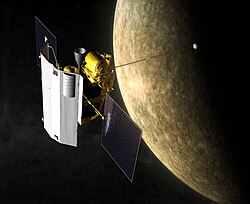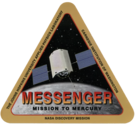From Simple English Wikipedia, the free encyclopedia
MESSENGER
 Artist's rendering of
MESSENGER
orbiting Mercury.
|
|
| Mission type
| Mercury
probe
|
|---|
| Operator
| NASA
|
|---|
| COSPAR ID
| 2004-030A
|
|---|
| SATCAT
no.
| 28391
|
|---|
| Website
| messenger
.jhuapl
.edu
|
|---|
| Mission duration
| Total:
10 years, 8 months and 27 days
At Mercury:
4 years, 1 month and 14 days
En route: 7 years
Primary mission: 1 year
First extension: 1 year
[1]
Second extension: 2 years
[2]
[3]
|
|---|
|
|
|
|
| Manufacturer
| Applied Physics Laboratory
|
|---|
| Launch mass
| 1,107.9 kg (2,443 lb)
|
|---|
| Power
| 450 watts
|
|---|
|
|
|
|
| Launch date
| August 3, 2004, 06:15:56
(
2004-08-03UTC06:15:56Z
)
UTC
|
|---|
| Rocket
| Delta II 7925H-9.5
|
|---|
| Launch site
| Cape Canaveral
SLC-17B
|
|---|
| Entered service
| April 4, 2011
|
|---|
|
|
|
|
| Disposal
| Deorbited
|
|---|
| Destroyed
| April 30, 2015 at 19:26 UT
[4]
|
|---|
|
|
|
|
| Reference system
| Hermiocentric
|
|---|
| Perihermion
| 200 kilometers (120 mi)
|
|---|
| Apohermion
| 10,300 kilometers (6,400 mi)
|
|---|
| Inclination
| 80 degrees
|
|---|
| Period
| 12 hours
|
|---|
| Epoch
| Jan 1, 2000
[5]
|
|---|
|
|
|
|
| Closest approach
| August 2, 2005
|
|---|
| Distance
| 2,347 kilometers (1,458 mi)
|
|---|
|
| Closest approach
| October 24, 2006
|
|---|
| Distance
| 2,990 kilometers (1,860 mi)
|
|---|
|
| Closest approach
| June 5, 2007
|
|---|
| Distance
| 337 kilometers (209 mi)
|
|---|
|
| Closest approach
| January 14, 2008
|
|---|
| Distance
| 200 kilometers (120 mi)
|
|---|
|
| Closest approach
| October 6, 2008
|
|---|
| Distance
| 200 kilometers (120 mi)
|
|---|
|
| Closest approach
| September 29, 2009
|
|---|
| Distance
| 228 kilometers (142 mi)
|
|---|
|
| Orbital insertion
| March 18, 2011, 01:00 UTC
[6]
|
|---|
|
|

|
MESSENGER
,
ME
rcury
S
urface,
S
pace
EN
vironment,
GE
ochemistry and
R
anging, was an unmanned
NASA
and
APL
spacecraft
.
[7]
It was orbiting and studying the
planet
Mercury
.
[7]
Its mission lasted 10 years, 8 months and 28 days.
It was launched on August 3, 2004
[7]
[8]
at
Cape Canaveral Air Force Station
. It was aboard a
Boeing
Delta II
rocket
.
[8]
After launch, the probe did several
fly-bys
and
deep space manoeuvres
to gain the right
trajectory
and
speed
.
[7]
It completed 30% mapping of Mercury on January 14, 2008. MESSENGER made one more pass by Mercury in 2009, and on March 18, 2011 began to
orbit
Mercury.
[7]
[9]
100% mapping was completed in March 2013 and the probe continued its studies. On April 30, 2015, it crashed into Mercury. It crashed near the crater Jana?ek.
- ↑
"NASA extends spacecraft's Mercury mission"
. UPI. November 15, 2011
. Retrieved
December 20,
2012
.
- ↑
Wu, Brian (April 3, 2015).
"NASA Set to Extend Mercury Mission for Another Month"
.
Johns Hopkins University APL
. The Science Times
. Retrieved
April 4,
2015
.
- ↑
"MESSENGER's Operations at Mercury Extended"
.
Johns Hopkins University APL
. SpaceRef.com. April 3, 2015
. Retrieved
April 4,
2015
.
[
permanent dead link
]
- ↑
"Beyond Earth: A Chronicle of Deep Space Exploration"
.
- ↑
Domingue, D.L.; Russell, C.T. (2007).
Messenger mission to Mercury
(1st ed.). New York: Springer. pp.
225
?245.
ISBN
9780387772141
.
- ↑
Lee, Jimmy; Galuska, Mike (March 18, 2011).
"NASA Chats ? MESSENGER Prepares to Orbit Mercury"
. NASA. Archived from
the original
on June 7, 2011
. Retrieved
March 18,
2011
.
- ↑
7.0
7.1
7.2
7.3
7.4
How it works book of amazing technology : everything you need to know about the world's best tech
. Bournemouth: Imagine Pub. 2011. pp. 48?49.
ISBN
978-1-908222-08-4
.
OCLC
784550467
.
- ↑
8.0
8.1
"Launch Coverage: MESSENGER Mission"
. NASA. Archived from
the original
on 2011-08-04
. Retrieved
2011-07-30
.
- ↑
Murchie, Scott L.; Vervack Jr., Ronald J.; Anderson, Brian J. (March 2011), "Journey to the Innermost Planet",
Scientific American
, vol. 304, no. 3, New York, pp. 26?31,
Bibcode
:
2011SciAm.304c..34M
,
doi
:
10.1038/scientificamerican0311-34
,
PMID
21438487